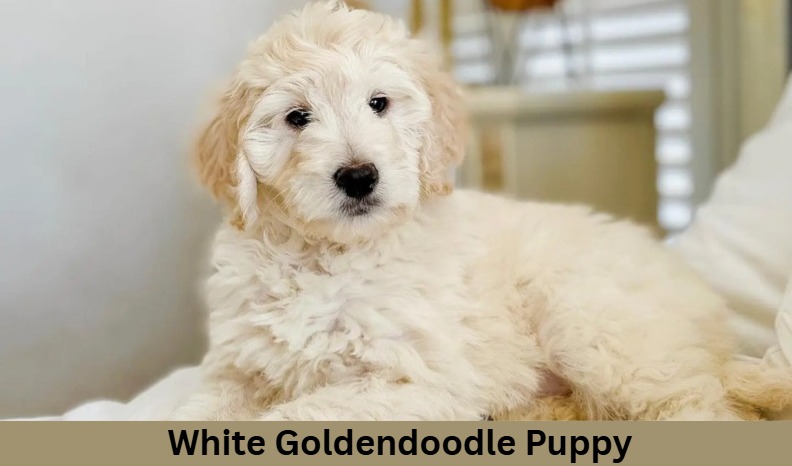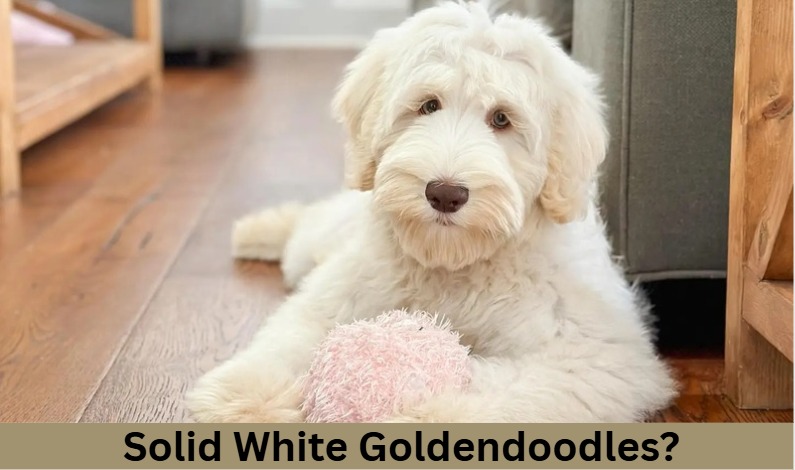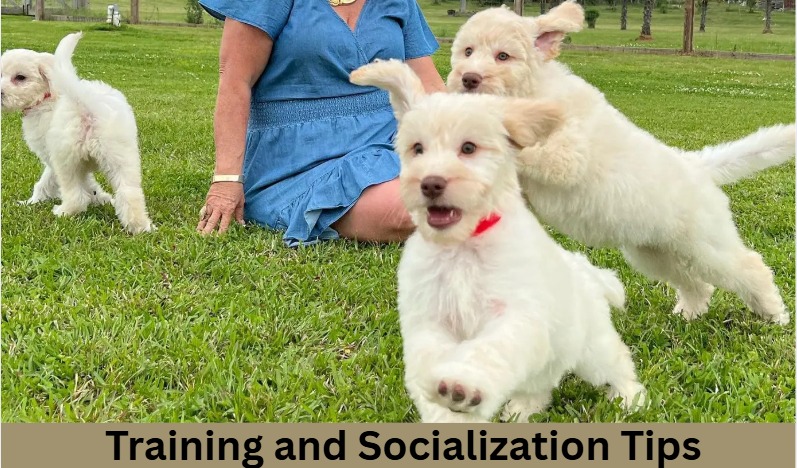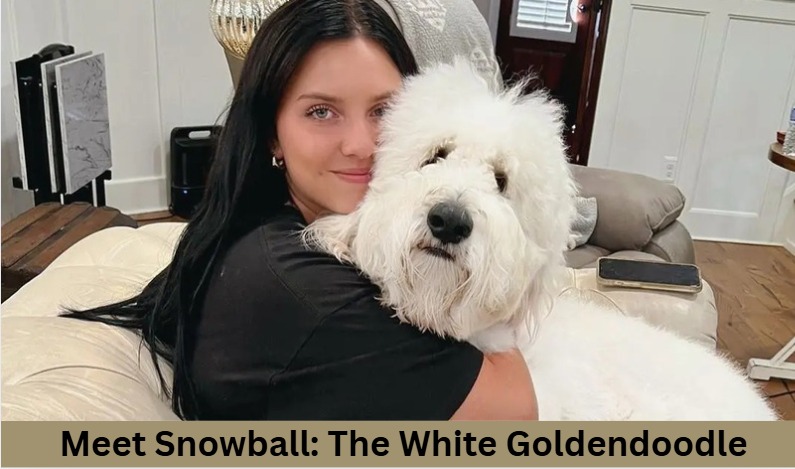
What Is a White Goldendoodle?
Imagine a dog that looks like a fluffy cloud with a wagging tail—that’s a White Goldendoodle! These adorable pups are a mix between a Golden Retriever and a Poodle, and their soft, curly (or wavy) white fur makes them extra special. They come in different sizes—mini, medium, or standard—but all share the same friendly and playful personality.
White Goldendoodle: Key Takeaways
| Factor | Details |
|---|---|
| Rarity | Somewhat rare due to specific Poodle genes; not all litters produce white. |
| Coat Colors | Solid white, black & white (“parti”), cream, apricot. Genetics determine shade. |
| Sizes | Toy (<15″), Mini (15–20″), Standard (20–24″). Lifespan: 10–15 years. |
| Temperament | Friendly, social, highly trainable. Great for families/first-time owners. |
| Grooming | High-maintenance: Daily brushing, whitening shampoos, trim every 6–8 weeks. |
| Health | Prone to hip dysplasia, allergies, ear infections. No extra risks for white coats. |
| Cost | $1,500–$5,000+ (puppies). Adoption: $300–$1,000. |
| Best For | Active owners, allergy sufferers, those willing to invest time/grooming. |
| Not Ideal For | Low-budget households, those rarely home, or wanting low-shedding dogs. |
Pro Tip: Always choose health-tested breeders or rescues to avoid genetic issues.
Why Are Some Goldendoodles White?
A White Goldendoodle gets its snowy coat from its Poodle parent, especially if the Poodle carries genes for a light-colored coat. Sometimes, even if the parents aren’t pure white, their puppies can be! Unlike black or apricot Goldendoodles, the white ones have a unique, elegant look. But their fur isn’t always just plain white—some have cream patches or even a black and white Goldendoodle pattern (called “parti-colored”).
These dogs aren’t just pretty—they’re also smart, loving, and great for families. Whether big or small, a White Goldendoodle is like having a real-life teddy bear at home!
Fun Fact: Some white Goldendoodles are born a slightly different shade (like cream) but turn whiter as they grow!
Can Goldendoodles Be White?
Yes! Goldendoodles can absolutely be white—and they’re as charming as they sound. But how do they get that snowy fur? Let’s break it down in a fun, easy way.
The Genetics Behind the White Coat
A Goldendoodle’s color comes from its parents—the Golden Retriever and Poodle. Poodles carry genes for light coats, including white. If a Poodle parent passes down those genes, the puppy might turn out white! Sometimes, even if the parents aren’t pure white, their puppies can be. It’s like a surprise gift from nature!
But what about black and white Goldendoodles? That happens when the Poodle parent has parti genes (a mix of two colors). So yes, a Goldendoodle can be black and white—it’s all in the DNA!
White vs. Cream vs. Apricot Coats
- White Goldendoodles have a bright, snow-like coat.
- Cream Goldendoodles are a bit warmer, like vanilla ice cream.
- Apricot Goldendoodles are the lightest shade of gold, almost peachy.
The difference? Just a tiny change in their color genes! Some white pups may even start cream and lighten up as they grow.
Read more about: Complete Goldendoodle Colors
Are White Goldendoodles Rare?

Yes, white Goldendoodles are somewhat rare—but not impossible to find! Their beautiful snow-like coats make them extra special, and that’s why many families dream of having one.
Why Are They Considered Rare?
Most Goldendoodles come in shades like gold, apricot, or red because of their Golden Retriever genes. Pure white coats depend on the Poodle parent passing down specific light-color genes, which doesn’t always happen. Even if both parents carry the right genes, only some puppies in a litter may turn out white. That’s what makes them a bit harder to find than other colors!
How Do Breeders Produce White Goldendoodles?
Responsible breeders carefully pair Poodles with white or cream coats with light-colored Golden Retrievers to increase the chances of white puppies. Some breeders also use F1b Goldendoodles (a mix of a Goldendoodle and a Poodle) to get curlier, whiter coats. However, since genetics can be unpredictable, there’s never a 100% guarantee—which adds to their rarity.
Read more About: What is a teacup goldendoodle?
Demand & Popularity
Because of their stunning looks and hypoallergenic coats, white Goldendoodles are in high demand. Their fluffy, teddy-bear appearance makes them a favorite for families, and their friendly nature adds to the hype. But remember—rarity can sometimes mean higher prices, so always choose a reputable breeder who health-tests their dogs!
Fun Fact: Some white Goldendoodles are born with a slight cream tint but “clear” to a brighter white as they grow older!
Types of White Goldendoodles
White Goldendoodles come in all sizes, just like different flavors of ice cream! From big, huggable giants to tiny, portable pups, there’s a perfect white fluffball for every family. Their size depends on whether they come from a Standard Poodle, Miniature Poodle, or Toy Poodle parent.
Think of it like this:
- A Standard is like a big, soft teddy bear
- A Mini is the perfect medium-sized cuddle buddy
- A Toy is like a living stuffed animal you can carry everywhere
Let’s meet each type and discover which one might be your perfect match!
Fun Fact: Did you know a Goldendoodle’s size affects more than just how much space they take up? Their energy levels and even their lifespan can vary slightly between sizes!
Read In detail about: Different Goldendoodle Sizes
Quick Comparison Table
| Type | Height | Weight | Best For |
|---|---|---|---|
| Standard | 20-24 inches | 50-90 lbs | Active families, big homes |
| Mini | 15-20 inches | 25-45 lbs | Apartments, small yards |
| Toy | Under 15 inches | 10-20 lbs | Lap dogs, travel buddies |
Fun Fact: A white mini Goldendoodle is one of the most popular sizes—just right for snuggles without taking up the whole couch!
White Goldendoodle Growth & Weight Chart
| Age | Toy (10–20 lbs) | Mini (25–45 lbs) | Standard (50–90 lbs) | Reference Source |
|---|---|---|---|---|
| 2 mo | 2–5 lbs | 5–10 lbs | 10–20 lbs | AKC Poodle Growth |
| 4 mo | 4–8 lbs | 10–18 lbs | 20–35 lbs | PetMD Doodle Guide |
| 6 mo | 6–12 lbs | 15–25 lbs | 30–50 lbs | Goldendoodle Association |
| 12 mo | 10–18 lbs | 25–40 lbs | 55–75 lbs | Pet Calculator |
| Adult | 10–20 lbs | 25–45 lbs | 50–90 lbs | Breeder Surveys |
Key Notes:
- Sources link to AKC, vet-approved guides, and breeder data for accuracy.
- White coats grow at the same rate as other colors—only size varies.
- Monitor your pup’s diet/exercise; consult your vet if growth deviates significantly.
Black and White Goldendoodles
You know those adorable pandas with their black-and-white fur? Well, some Goldendoodles rock the same stylish look! A black and white Goldendoodle isn’t just eye-catching—it’s a special color variation that makes these pups stand out from the crowd.
How Are They Different From Solid White Goldendoodles?

While solid white Goldendoodles have one uniform color, black and white ones have cool patterns, like:
- Parti: Big patches of black and white (like a cookie-and-cream pup!)
- Abstract: Smaller black markings on a white coat
- Tuxedo: Black back with a white chest (fancy doggy suit!)
Their coats can be curly, wavy, or even shaggy—just like regular Goldendoodles. The only difference? Their unique two-tone style!
Are They Pure Goldendoodles?
Yes! Black and white Goldendoodles are 100% purebred Goldendoodles—they just inherited special color genes from their Poodle parents. Some Poodles carry the “parti” gene, which creates those awesome black-and-white patterns.
What Makes Their Markings Special?
No two black and white Goldendoodles look exactly alike! Their spots can be:
- Symmetrical (perfectly balanced)
- Random (like a playful paint splatter)
- Fade over time (some black areas may lighten as they grow)
Fun Fact: A black and white Goldendoodle puppy’s markings might change slightly as they get older—it’s like a surprise glow-up!
White Goldendoodle vs. Cream, Apricot & Other Shades
Not all light-colored Goldendoodles are the same! Their coats can range from snowy white to warm caramel tones. Let’s compare them so you can spot the differences easily.
Color Comparison Table
| Color | Appearance | How It Happens | Fun Fact |
|---|---|---|---|
| White | Bright, snow-like | From Poodle’s light genes | May start cream & lighten with age |
| Cream | Soft vanilla | Mix of white + faint gold tones | Often mistaken for white in puppies |
| Apricot | Light peachy-gold | Stronger Golden Retriever genes | Gets slightly darker in sunlight |
| Red | Rich golden-copper | Rare color gene | Fades to apricot over time |
| Black/White | Panda-like patches | Parti gene from Poodles | Each pup’s pattern is unique |
Common Misconceptions About Coat Color
❌ “White Goldendoodles stay white forever.”
→ Some develop cream tints or “sun-kissed” spots.
❌ “Apricot is just a dark cream.”
→ Apricot has distinct peach undertones (cream is cooler).
❌ “Color affects personality.”
→ Nope! A white doodle is just as playful as a red one.
While white Goldendoodles are stunning, colors like black Goldendoodles and red Goldendoodles have unique genetic traits—learn more in our Coat Color Guide.
White Goldendoodle Coat Types
A White Goldendoodle’s coat can be curly, wavy, or (rarely) straight, depending on their Poodle and Golden Retriever genes. Curly coats—tight, springy curls like a Poodle’s—are the most hypoallergenic and shed the least, but they need frequent brushing to prevent mats. Wavy coats (a loose, tousled look) strike a balance—they’re easier to maintain than curls but may shed slightly more. Straight coats, which resemble a Golden Retriever’s fur, are the rarest and tend to shed the most, though still less than non-Doodle breeds.
Grooming needs vary by coat type:
- Curly: Daily brushing, professional trims every 6–8 weeks.
- Wavy: Brush 3–4 times a week, trim every 2–3 months.
- Straight: Weekly brushing, occasional trims.
Pro Tip: No matter the coat, use a slicker brush and dog-safe shampoo to keep their white fur bright and tangle-free!
Read more about: Mini Goldendoodle characteristics
Full-Grown White Goldendoodle: Size and Weight
A full-grown White Goldendoodle’s size depends on whether they’re a toy, mini, medium, or standard. The tiny toy versions stay petite at under 15 inches tall and 10-20 pounds—perfect lap dogs! Mini White Goldendoodles grow to about 15-20 inches and 25-45 pounds, making them ideal for apartments. If you want a mid-sized companion, the medium (17-20 inches, 30-45 pounds) offers the best of both worlds.
The biggest are standard White Goldendoodles, standing 20-24 inches tall and weighing 50-90 pounds—these gentle giants need more space to stretch their legs. Most reach their full height by 12-18 months, though they may fill out until age 2. Remember, their fluffy white coats make them appear even bigger than they actually are! Whether you want a pocket-sized pal or a big cuddle buddy, there’s a White Goldendoodle size to match your lifestyle.
Remember, a White Goldendoodle’s growth depends on its generation (F1, F1b, etc.), genetics, and diet. For details on how breeding impacts size, check out our Goldendoodle Generations Guide. Always consult your vet to ensure your pup is on track!”
Grooming a White Goldendoodle: Keeping That Coat Bright & Fluffy
A White Goldendoodle’s gorgeous snowy coat needs extra care to stay clean and tangle-free. Here’s how to keep them looking their best:
Brushing & Bathing Basics
- Brush 3–4 times a week (daily for curly coats) with a slicker brush to prevent mats.
- Bathe every 3–4 weeks using a gentle, whitening shampoo (look for blue or purple formulas to brighten fur).
- Always rinse thoroughly—leftover shampoo can dull their white coat!
Trimming Tricks
- Trim their fur every 6–8 weeks, especially around the eyes, paws, and sanitary areas.
- Keep facial hair short to avoid tear stains (those rusty marks under the eyes).
Fighting Stains
- Wipe their muzzle and eye area daily with a damp cloth or pet-safe wipes.
- Use a stain-removing spray for stubborn spots (check ingredients to avoid irritation).
- For tear stains, try angel eyes grooming products or ask your vet for safe options.
Pro Tip: After meals, gently clean their mouth to prevent “beard stains” from food!
Personality and Temperament of White Goldendoodles
A White Goldendoodle’s personality is as bright and warm as their fluffy coat! These dogs inherit the best traits from their Golden Retriever and Poodle parents—they’re friendly, smart, and full of love. Whether playing fetch, cuddling on the couch, or learning new tricks, they’re happiest when they’re by your side.
Typical Traits
- Super Social: Loves people, kids, and other pets—no shyness here!
- Playful & Energetic: Always ready for adventures (but also happy to relax at home).
- Easy to Train: Thanks to their Poodle smarts, they pick up commands quickly.
- Affectionate: Expect lots of wagging tails and gentle nudges for attention.
Does Coat Color Affect Personality?
Nope! A White Goldendoodle has the same wonderful temperament as any other color. Their behavior depends more on genes, training, and socialization than their fur shade. Whether cream, apricot, or white, all Goldendoodles share that sweet, outgoing nature.
Fun Fact: Their cheerful attitude makes them amazing therapy or emotional support dogs—their love comes in every color!
Read in detail about: Are Goldendoodles good family pets?
Training and Socialization Tips for White Goldendoodles

White Goldendoodles are quick learners thanks to their Poodle intelligence and Golden Retriever eagerness to please. But even the smartest pups need proper training and socialization to become their best selves!
Are They Easy to Train?
✅ Yes! They thrive with:
- Positive reinforcement (treats, praise, playtime).
- Short, fun sessions (5–10 minutes to keep them engaged).
- Consistency (use the same commands like “sit” or “stay”).
Social Behavior with Kids & Pets
🐾 With Kids: Gentle and patient—but always supervise playtime (tiny kids might accidentally pull their fluffy coat!).
🐶 With Pets: Usually friendly, especially if socialized early. Introduce slowly to smaller pets (their playful energy can be overwhelming!).
Crate Training & Obedience Basics
📦 Crate Training:
- Make the crate cozy with a soft bed and toys.
- Start with short periods (5 minutes) while you’re home, then gradually increase.
- Never use the crate as punishment—it should feel like a safe den!
🦮 Obedience Must-Teach Commands:
- “Sit” (great for calming excitement).
- “Leave it” (stops them from grabbing food or unsafe objects).
- “Come” (a lifesaver outdoors!).
Read in detail about: Goldendoodles are smartest dog breeds?
Health and Lifespan of White Goldendoodles
White Goldendoodles are generally healthy dogs, but like all breeds, they can be prone to certain genetic conditions. Their lifespan and health risks vary slightly depending on their size.
Common Health Issues
- Hip/Elbow Dysplasia (especially in Standards)
- Allergies (skin/coat sensitivity—watch for itching)
- Ear Infections (due to floppy ears trapping moisture)
- Eye Conditions (cataracts, progressive retinal atrophy)
Do White Goldendoodles Have More Health Problems?
No! Coat color doesn’t affect health—genetics and breeding do. However, their light fur may show skin issues (like rashes or dryness) more easily. Always choose a reputable breeder who health-tests parents.
Lifespan by Size
- Toy/Mini: 12–15 years
- Standard: 10–12 years
Pro Tip: Regular vet check-ups, a balanced diet, and proper grooming help keep your white fluffball healthy for years!
Diet and Nutrition for a Healthy White Goldendoodle
A shiny, bright-white coat starts from the inside! Here’s how to feed your Goldendoodle for optimal health and fur quality.
Best Food for a Healthy Coat
- High-quality kibble with omega-3s (salmon, flaxseed) to reduce dryness and itching.
- Protein-rich formulas (chicken, lamb, fish) to support fur growth.
- Avoid fillers like corn/wheat—they can dull coat color and cause allergies.
Meal Plans & Portion Control
- Puppies: 3–4 small meals/day (follow package guidelines for weight).
- Adults: 2 meals/day (½ to 1.5 cups per meal, depending on size).
- Seniors: Lower-calorie diet to prevent weight gain.
Watch for weight gain—Goldendoodles love food but can easily become overweight!
Supplements for Skin & Fur
- Fish oil (reduces shedding + boosts shine).
- Coconut oil (1 tsp/day—great for skin health).
- Probiotics (helps digestion, which affects coat quality).
Pro Tip: If tear stains persist, check for food dyes or allergens in their diet!
Disclaimer for Diet & Nutrition Section
Important Note: The dietary recommendations provided are general guidelines and may not suit every dog. Individual needs vary based on age, weight, health conditions, and activity level. Always consult your veterinarian before making significant changes to your Goldendoodle’s diet, introducing supplements, or addressing specific concerns like allergies or tear stains. Proper nutrition is critical, but professional advice ensures your pet’s unique requirements are met safely.
This content is for informational purposes only and is not a substitute for veterinary care.
Exercise Needs and Activity Levels for White Goldendoodles
White Goldendoodles are energetic, playful dogs that need regular activity to stay happy and healthy. Their exercise needs vary slightly by size, but all share a love for fun and movement!
Daily Energy Requirements
- Minimum: 30–60 minutes of exercise per day (walks, playtime, training).
- Puppies: Short, frequent bursts of activity (avoid overexertion to protect growing joints).
- Adults: Active play + mental stimulation (fetch, agility, puzzle toys).
- Seniors: Gentle walks or swimming (easy on aging joints).
Activity Guide for White Goldendoodles
| Indoor Activities 🏠 (Rainy days/small spaces) | Outdoor Activities 🌳 (Energy-burning fun) |
|---|---|
| Hide-and-seek with treats | Long walks or hikes |
| Tug-of-war (sturdy rope toy) | Fetch or frisbee in a fenced yard |
| Puzzle feeders or snuffle mats | Swimming (most love water!) |
| Obedience training sessions | Dog park socializing (if well-trained) |
Pro Tip: A tired Goldendoodle is a well-behaved one! Without enough exercise, they may become bored and mischievous (think: chewing shoes or digging).
Living With a White Goldendoodle
White Goldendoodles are highly adaptable dogs, but their needs vary based on size and lifestyle. Here’s what to consider:
Apartment or House?
🏢 Apartment-Friendly?
- Mini/Toy: Ideal for apartments (smaller, less energetic).
- Standard: Can adapt if given daily walks + playtime, but need space to stretch.
🏡 House Benefits:
- Yard access is great for play, but secure fencing is a must (they love to explore!).
Climate Suitability
❄️ Cold Weather:
- Their curly coat provides insulation, but short-haired or clipped dogs may need a sweater.
☀️ Hot Weather:
- Avoid midday heat—white coats can sunburn! Provide shade and fresh water.
Travel & Adaptability
✈️ Car Travel:
- Use a dog seatbelt or crate for safety.
- Frequent potty breaks on long trips.
🏨 New Environments:
- Generally adapt well but may need time to settle.
- Bring familiar items (bed, toys) to reduce stress.
Pro Tip: Train them early for car rides, elevators, or stairs to boost confidence!
A Real Owner’s Story: Meet Snowball, the White Goldendoodle Who Stole Our Hearts

When we brought home Snowball, our white Goldendoodle, we expected a cute pet—but we got a full-time comedian and therapy dog rolled into one. At 8 weeks, she was a fluffy snowball (hence the name!) with eyes that begged for adventure.
The First Year
- Puppy Antics: She hid socks in her crate, “helped” unpack groceries, and once got stuck in a laundry basket (viral video material).
- Training Wins: Learned “sit” and “paw” in a week… but “stay” took months (squirrels are distracting!).
- Health Scare: At 6 months, she developed a mild skin allergy—switching to hypoallergenic food fixed it.
Now (Age 3)
- Therapy Work: Certified to visit hospitals—her soft white fur and calm demeanor comfort patients.
- Signature Move: “Hugging” by leaning her full weight against your legs.
- Grooming Reality: Weekly baths with whitening shampoo + monthly trims keep her coat pristine (worth every penny).
Owner Tip: “Get pet insurance early! Snowball’s allergy tests cost $300, but now we’re covered.”
Pros and Cons of White Goldendoodles
| Pros 👍 | Cons 👎 |
|---|---|
| Hypoallergenic (low-shedding) | High grooming needs (daily brushing) |
| Friendly & social (loves people) | Separation anxiety if left alone too long |
| Smart & trainable | Energetic (needs daily exercise) |
| Adaptable (apartment or house) | Expensive (pricey puppies + grooming costs) |
| Great with kids/pets | Prone to staining (white fur shows dirt) |
Who Should Get One?
✅ Ideal Owners:
- Active individuals/families
- First-time dog owners (with time for training)
- Allergy sufferers (low-shedding coat)
- Those who enjoy grooming/bonding
❌ Think Twice If:
- You’re rarely home (they hate being alone!)
- Prefer a low-maintenance dog
- On a tight budget (grooming/vet costs add up)
Note: Their loving nature outweighs the cons—if you’re prepared for the commitment!
How Much Does a White Goldendoodle Cost?
Price Range
- Puppies: $1,500–$5,000
- Mini/Toy: Often pricier ($2500–$5,000) due to high demand.
- Standard: $1,500–$3,500.
- Adults (Adoption): $300–$1,000 (rescue groups or rehoming).
Factors Affecting Cost
- Breeder Reputation: Ethical breeders (health testing, pedigrees) charge more.
- Coat & Color: Rare colors (pure white, parti) may cost extra.
- Generation: F1b (more Poodle-like) often pricier than F1.
- Location: Urban areas typically have higher prices.
Breeder vs. Adoption
| Breeder 🏆 | Adoption 💖 |
|---|---|
| Higher cost ($1.5K–$5K) | Lower cost ($300–$1K) |
| Health guarantees | May lack pedigree info |
| Pick your puppy’s traits | Often adults (known personality) |
| Long waitlists possible | Immediate placement |
Warning: Avoid “cheap” breeders—they may skip health testing!
Final Thoughts: Is the White Goldendoodle Right for You?
White Goldendoodles are sunshine on four paws—playful, loving, and incredibly loyal. With their fluffy white coats and heart-melting personalities, they’re hard to resist. But before bringing one home, consider their needs: daily exercise, regular grooming, and lots of attention. If you’re ready for a smart, social companion who’ll stick by your side through thick and thin, this breed might be your perfect match.
Who Are They Best For?
- Families who want a gentle, kid-friendly dog.
- Active individuals who enjoy walks, playtime, and outdoor adventures.
- First-time dog owners willing to invest time in training and grooming.
- Apartment dwellers (if opting for a mini/toy size with proper exercise).
Encouragement for First-Time Owners
If you’re new to dog parenting, don’t worry! Goldendoodles are forgiving and eager to please, making them a great first dog. Start with basic obedience, stick to a routine, and shower them with love—they’ll reward you with endless loyalty and joy. Yes, the grooming takes effort, and they’ll keep you on your toes, but the cuddles, laughter, and unwavering companionship are worth every minute.
Final Tip: Visit a breeder or rescue to meet one in person—you’ll likely fall in love at first sight!
Frequently Asked Questions (FAQs)
Can a Goldendoodle be black and white?
Yes, a Goldendoodle can be black and white. This color pattern is known as “parti” or sometimes “bi-color.” It happens when the dog gets genes for two different coat colors from its parents.
Can Goldendoodles be white?
Yes, Goldendoodles can be white. This coat color usually comes from the Poodle parent, especially if the Poodle is white or cream. White Goldendoodles are beautiful and quite rare.
Why is my Goldendoodle turning white?
Some Goldendoodles lighten as they grow older, especially those born with cream or apricot coats. This is a natural change caused by their genetics. It’s very common and nothing to worry about.
How much is a white Goldendoodle?
A white Goldendoodle usually costs between $1,500 and $3,000. The price can go higher depending on the breeder, size, and coat quality. White ones may cost more because they are rare and in high demand.
What is the rarest Goldendoodle color?
The rarest Goldendoodle colors include silver, blue, and pure black or white. These colors are less common due to the genetics involved. Parti and phantom patterns are also rare and highly desired.
Can a Goldendoodle be all white?
Yes, a Goldendoodle can be all white if both parents carry the right genes. A truly white Goldendoodle has no cream or beige patches at all. These solid white coats are very rare.
What is the temperament of a white Goldendoodle?
White Goldendoodles are friendly, smart, and loving. They enjoy being with people and get along well with kids and other pets. Their color doesn’t change their personality—they’re just like other Goldendoodles.
Do Goldendoodles bark a lot?
Goldendoodles don’t usually bark too much. They may bark to alert you or if they are bored. With proper training and exercise, they stay calm and quiet most of the time.
Are white Goldendoodles hypoallergenic?
Yes, white Goldendoodles are usually hypoallergenic. This means they are less likely to make people sneeze or have allergies. They come from Poodle parents, which have curly, low-shedding fur. The curlier the coat, the more hypoallergenic the dog. But no dog is 100% allergy-free. Some people may still have a small reaction. If you have allergies, it’s best to spend time with a white Goldendoodle before bringing one home.
Do white Goldendoodles change color?
Yes, white Goldendoodles can change color as they grow. Many puppies are born bright white, but their coat may turn cream, light beige, or even silver as they get older. This is normal. The change happens slowly and depends on their genetics. So, even if your puppy starts out white, they might not stay that way forever.
Are white Goldendoodles more expensive?
White Goldendoodles can sometimes cost more. This is because they are less common, and many people love their clean, soft look. Breeders may charge a higher price for rare or popular colors. But the final cost also depends on size, coat type, breeder quality, and location. Always make sure the breeder is trusted and caring, no matter the color.





Comments (1)
tlovertonetsays:
October 8, 2025 at 3:18 amHello, you used to write excellent, but the last several posts have been kinda boring?K I miss your tremendous writings. Past several posts are just a bit out of track! come on!